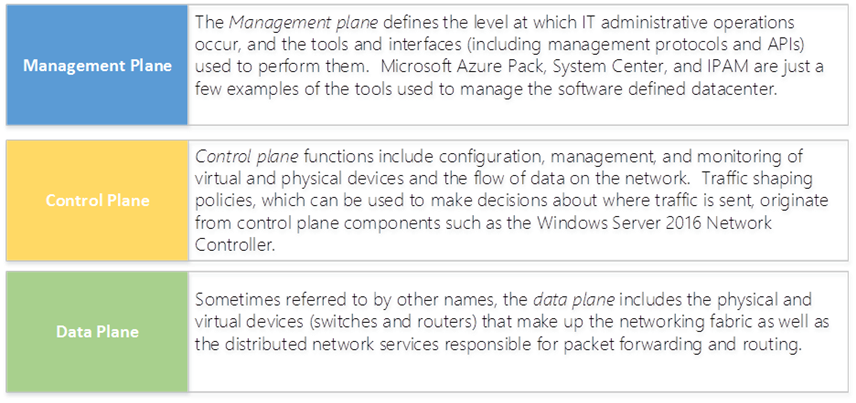Tip of the Day: Demystifying Software Defined Networking Terms - The Concepts
Today’s Tip…
The Cloud Datacenter and Software Defined Networking comes with a dizzying array of terms; some old and familiar, and some new. Digesting it all can be rather daunting if you don’t already have a background in wide area network (WAN) and datacenter topology design.
More or less a continuation of a previous tip series, Cloud Datacenter Networking in 10 Minutes or Less, this tip series provides brief explanations of these terms, by grouping them by their conceptual place in the software-defined datacenter to provide additional context.
In This Series:
- The Concepts
- The Components
- The Cloud Compass
- The Technologies
- The Hardware
Part I: The Concepts
Terms in this tip include
- Software Defined Networking (SDN)
- Network Fabric
- Management Planes
- Network Abstraction
- Network Overlay
- Network Underlay
- Converged Networks
Software Defined Networking (SDN) - Software Defined Networking (SDN) provides a method to centrally configure and manage both physical and virtual network devices in a datacenter. SDN manageability extends to logical aspects of network design as well, including elements such as IP addresses, IP subnets, and so on.
Virtual network elements such as Hyper-V Network Virtualization, the Hyper-V Virtual Switch, Windows Server Gateways, and other software-based components are designed to be integral elements of a software defined networking infrastructure.
Physical devices still have a place in a software-defined datacenter. While existing physical switches, routers, and other hardware devices can be used, deeper integration is achieved when devices are designed for compatibility with software defined networking management protocols.
Network Fabric - Network fabric is a collective reference to physical and virtual networking devices on the data plane.
Management Planes - Management Planes are a way of categorizing the operations that occur within the datacenter infrastructure, and are made up of the management, control, and data planes.
Figure 1: Software Defined Plane Abstractions
Network Abstraction - Network abstraction refers to the separation of management and policy control functions from the network devices. Software defined networking is possible because the network planes - the management, control, and data planes - are no longer bound to the devices themselves, but are abstracted for use by other entities, such as datacenter management software like System Center.
Through abstraction, software defined networking allows dynamic management of the datacenter network, providing the following capabilities.
- The ability to abstract applications and workloads from the underlying physical network, which is accomplished by virtualizing the network. Just as with server virtualization using Hyper-V, the abstractions are consistent and work with applications and workloads in a non-disruptive manner (meaning they are unaware of any abstraction or virtualization). For example, software defined networking provides virtual abstractions for your physical network elements, such as IP addresses, switches, and load balancers.
- The ability to centrally define and control policies that govern both physical and virtual networks, including traffic flow between these two network types.
- The ability to implement network policies in a consistent manner at scale, even as you deploy new workloads or move workloads across virtual or physical networks.
Network Overlay - In an overlay network, one computer network is built on top of another. Nodes in the overlay can be thought of as being connected by virtual or logical links, each of which corresponds to a path, perhaps through many physical links, in the underlying network.
Nodes on the network overlay provide abstraction of management and traffic flow control from the underlying physical devices. Overlay characteristics include providing management interfaces for the creation of (resource allocation and traffic shaping) network policies, network control (assignment and enforcement of policy), and device configurations. SDN overlays include services such network controllers, virtual appliances, service chaining (to be discussed later), among others.
Network Underlay – The network underlay consists of the physical and virtual devices that make up the network fabric. Servers, switches, and gateways are all examples of underlay devices.
Converged Network – The term converged network, often referred to as network convergence, refers to the provision of storage, telephone, video and data communication services within a single network. In other words, one pipe is used to deliver all forms of communication services. Commonly this term is used in association with specialized network hardware, such as network interface cards (NICs), that provide features and capabilities designed to ensuring prioritization of computationally intensive (generally latency or I/O sensitive) workloads. Examples include hardware offload and direct memory access features.
Next Tip: The Components
